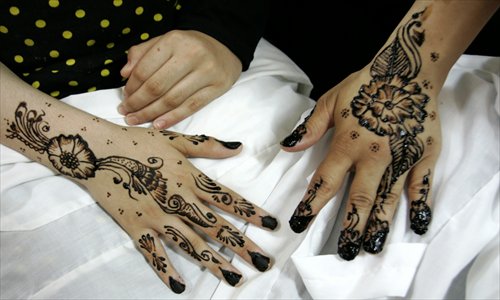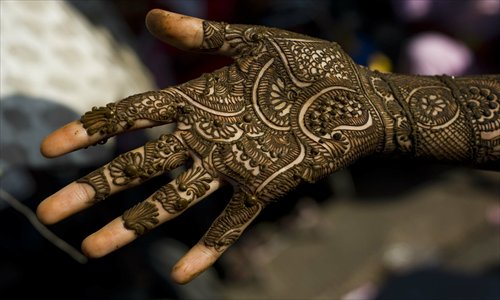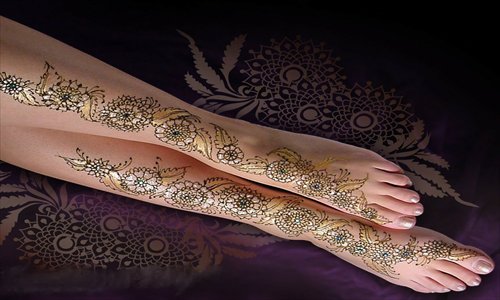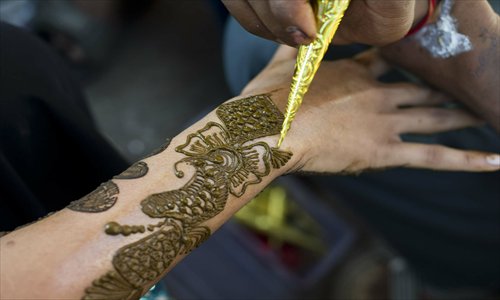The illustrated women
The night before their wedding, many Hindu and Muslim brides-to-be spend hours decorating their palms, forearms and ankles with Mehndi, a style of intricate, lavish body painting made with henna.
And when the body painting is complete, the bride's mother traditionally sings a song complimenting the bride and her beauty, and praising God for her imminent nuptials. The henna body painting is said to represent a family's blessing and good fortune.

Mysterious origins
Henna, strictly speaking, is not the name for the art of body painting, but the name of the plant from which the paint comes. Henna is a flowering plant that is crushed and mixed with water to create a natural dye. The plant is commonly grown in tropical and subtropical regions of Africa, South Asia and the Middle East.
The exact history and origins of the use of henna are uncertain, as this body art followed centuries of migration and cultural intermingling. What we know is that henna has been used as a skin dye since the Bronze Age for celebrations and festivals.
Henna body painting flourished in Europe in the early 19th Century. And in the past decade, some Hollywood A-listers and singers, including Miley Cyrus and Taylor Swift, have both popularized the use of henna for creating temporary tattoos.
In Shanghai, the "henna body painting experience" at the India Pavilion became a visitors' favorite during the World Expo 2010 in Shanghai. And today a number of beauty and spa salons in the city offer henna body painting for customers who want to get that exotic look this summer.

A hippy tradition
Tarandip Rehal, a Mehndi body-painting artist, came to Shanghai six years ago to teach English at a kindergarten and then decided she wanted to set up a henna body painting studio to make good use of her special skills in this field.
"Mehndi is a tradition that mothers of Punjabi families pass onto their daughters," Rehal, 42, from India, told the Global Times. "And setting up a body painting studio here is a way of spreading our proud traditions. And many young people in Shanghai love these temporary tattoos."
Rehal's studio is in a small alleyway off Shaanxi Road in downtown Jing'an district and is so busy on weekends that customers need to book at least three days in advance to reserve a two-hour appointment. Rehal's own family members mix the henna paste into a unique recipe that Rehal will pass onto her daughter when she retires. But she was happy to share the ingredients for the paste.
"Henna powder is the main ingredient, of course, and eucalyptus oil is also very important or the paste will run off the skin," she said. "I also use tea leaves and lemon juice, but the exact mixture of the ingredients is a family secret."
The color of this organic henna paste leaves honey-brown prints on the body, which Rehal said makes for particularly beautiful markings on Asian skin.
After applying the paste and waiting for about 20 minutes, the mixture will dry and crack. The painter will then pour a mixture of lemon juice and sugar onto the skin to remoisten the henna and to stain it darker. If the customer wants the temporary tattoo to last longer, Rehal can put medical tape over the dry henna paste for an hour or so in order to retain a higher body temperature which will help darken the print. The paste can only be removed by warm water when it dries completely after a couple of hours and the markings will fade naturally within three to four weeks.
It takes at least two hours for Rehal to draw the henna painting on one palm with bamboo stencils. The drawing requires very steady hands as the lines are extremely fine and intricate.
"Henna painting isn't only an art but a ritualistic custom in Indian culture," she said. "It is an artistic way for us to celebrate and to praise our Gods and Goddesses."
The price of a henna painting session by Rehal ranges from 300 yuan ($47.30) to 1,000 yuan, depending on the size of the painting. A full palm drawing costs 420 yuan and a full lower leg drawing costs 980 yuan.
Add: 457 Shaanxi Road North 陕西北路457号 Tel: 6258-5580

Henna DIY at home
If the price of a professional henna tattoo is too expensive, you may want to try one of the ready-made henna pastes that are available on taobao.com.
Some of the pastes are domestically made in China while others are imported from India and the Middle East. Price ranges from about 30 yuan to 80 yuan for a 30-gram tube. Search carefully if you want an all-natural henna paste.
Totally natural henna pastes are only available in limited colors, including dark brown and metallic red. All other colors - including purple, red and blue - are made with added colors in the paste. Some people may develop a slight skin allergy to the additives in these colorings and it's advisable to do a skin test 24 hours prior to a painting session if you want to opt for a more exotic color.
Choosing the right stencils is also very important, as the size of the stencil will affect the look of the individual lines within each henna painting.
And for those who aren't confident about making their own henna drawing, traditional henna molds are also available online. All you need to do is to fill in the spaces in the mold with henna paste.
